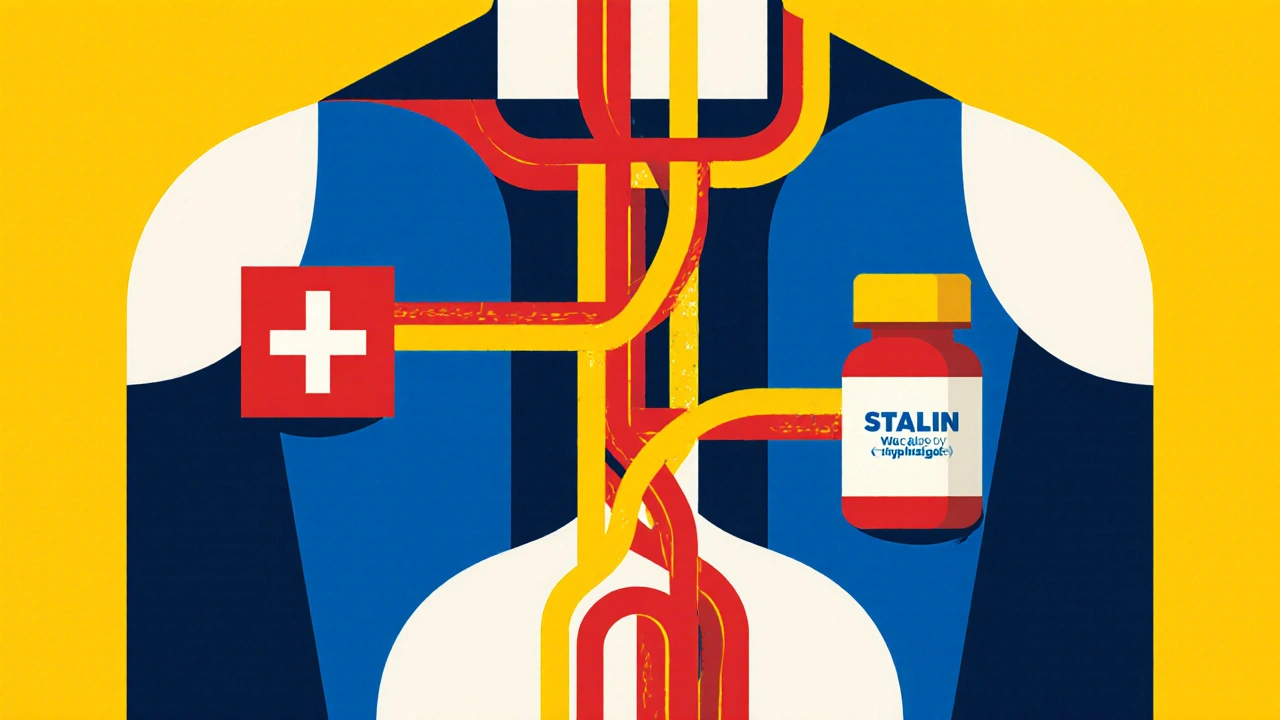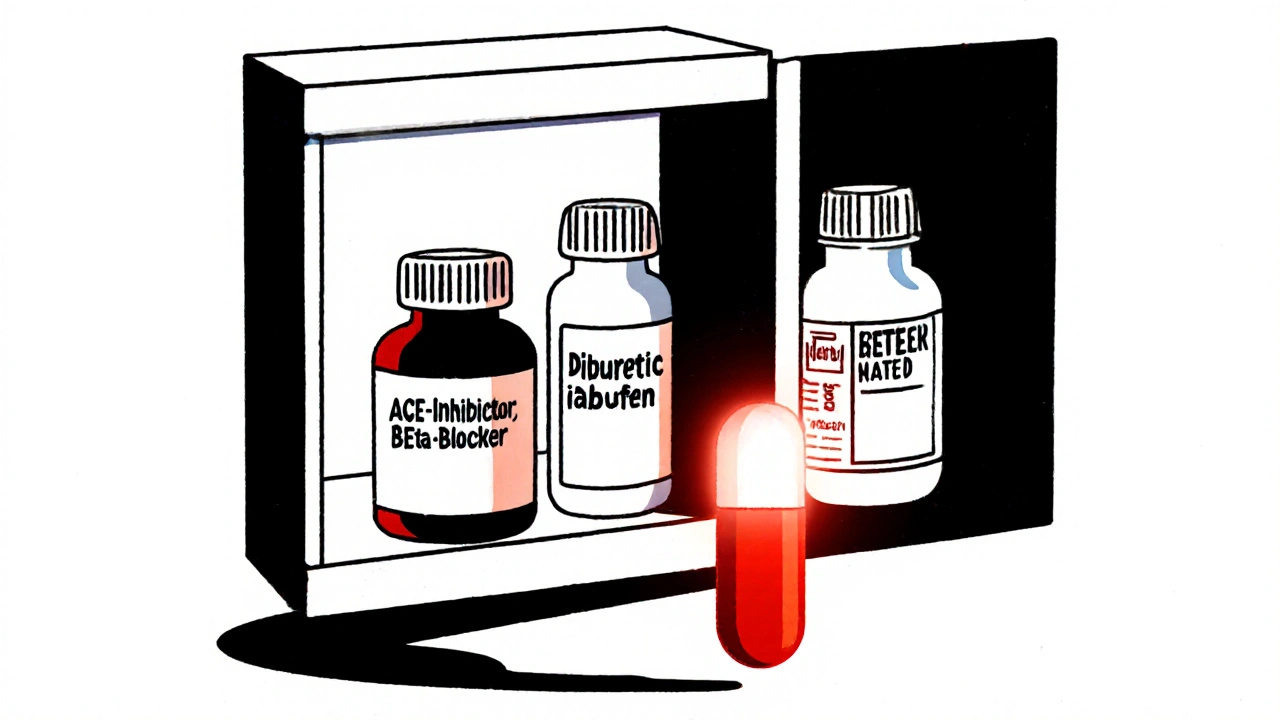Blood Pressure Medication Interaction Checker
Select your medications to see interaction results.
High blood pressure affects nearly half of all adults in the U.S., and for most, it’s managed with daily medication. But what happens when those pills mix with something as simple as an ibuprofen from the cabinet? The answer isn’t just a mild inconvenience-it can mean a trip to the ER, a hospital stay, or worse. Many people don’t realize that their blood pressure meds can react dangerously with common over-the-counter drugs, supplements, or even alcohol. This isn’t theoretical. It’s happening every day, and the consequences are real.
How Blood Pressure Medications Work-and Why They Clash
There are six main classes of hypertension medications, each with a different way of lowering blood pressure. Diuretics flush out extra fluid. Beta-blockers slow your heart rate. ACE inhibitors and ARBs relax blood vessels by blocking certain hormones. Calcium channel blockers prevent calcium from entering heart and artery cells. Alpha-blockers reduce nerve signals to blood vessels. All of them work well on their own. But when you add another drug into the mix, things can go wrong fast.The biggest problem? Polypharmacy. Nearly 40% of adults over 65 with high blood pressure take five or more medications daily. That’s not unusual. But it means every new pill-prescription or not-has a chance to interfere. Some interactions make the blood pressure meds less effective. Others make side effects worse. A few can be life-threatening.
NSAIDs: The Silent Saboteurs
Ibuprofen, naproxen, diclofenac-these are the most common pain relievers in households. But they’re also the most dangerous when taken with blood pressure medications. NSAIDs block enzymes that help your kidneys manage fluid and salt. That leads to fluid retention, which raises blood pressure. In fact, NSAIDs can undo up to 10 mmHg of systolic blood pressure control achieved by ACE inhibitors, ARBs, diuretics, or beta-blockers.Studies show that 25-30% of people on ACE inhibitors see their blood pressure rise within 48 hours of starting an NSAID. That’s not slow. That’s fast. And it’s why 12% of emergency visits for adverse drug events in hypertensive patients involve NSAIDs. Most of those cases? Ibuprofen from the drugstore shelf.
Here’s the kicker: acetaminophen (Tylenol) doesn’t do this. For mild to moderate pain, it’s just as effective and doesn’t interfere with blood pressure control. If you’re on a blood pressure med and need pain relief, acetaminophen is the safer choice-unless your liver can’t handle it.
When Beta-Blockers Go Wrong
Beta-blockers like metoprolol, atenolol, and propranolol are common, especially for people with heart disease. But they’re also among the most interact-prone drugs. Propranolol alone interacts with over 200 medications, according to FDA labeling.One dangerous combo? Beta-blockers and antidepressants, especially tricyclics like amitriptyline. Together, they can cause dizziness, low blood pressure when standing, and increase fall risk by 35% in older adults. That’s not just a stumble-it’s a broken hip waiting to happen.
Another risk? Digitalis (digoxin). Used for heart rhythm problems, it can cause dangerous bradycardia (slow heart rate) when combined with beta-blockers. The risk goes up by 25-30%. That’s why doctors check heart rates closely when both are prescribed.
And then there’s alcohol. It doesn’t just make you sleepy. It amplifies the drop in blood pressure caused by beta-blockers, leading to orthostatic hypotension-dizziness or fainting when standing up. That’s why patients are often told: if you’re on a beta-blocker, drink alcohol sparingly, if at all.

ACE Inhibitors, ARBs, and the Potassium Trap
ACE inhibitors (like lisinopril) and ARBs (like losartan) are favorites because they protect the kidneys and heart. But they also make your body hold onto potassium. That’s good if you’re low. Bad if you’re not.When you add potassium supplements, salt substitutes (which are often high in potassium), or even certain herbal teas, your potassium levels can spike. Hyperkalemia-high potassium-can cause irregular heart rhythms, muscle weakness, and even cardiac arrest. Studies show that combining ACE inhibitors or ARBs with potassium supplements triples the risk of dangerous hyperkalemia.
And yes, NSAIDs make this worse. They reduce kidney function, which means even less potassium gets flushed out. The American Heart Association recommends checking potassium levels every 3-6 months if you’re on an ACE inhibitor or ARB and taking NSAIDs. If your potassium is above 5.0 mEq/L, you need to adjust something-fast.
Calcium Channel Blockers and Statins: A Hidden Risk
Amlodipine, diltiazem, verapamil-these calcium channel blockers are great for lowering blood pressure. But they also interfere with how your liver breaks down certain statins, the cholesterol-lowering drugs many hypertensive patients take too.Simvastatin is the biggest concern. When taken with diltiazem or verapamil, simvastatin levels can jump by 77%. That’s not a small increase. It raises the risk of rhabdomyolysis-a condition where muscle tissue breaks down and floods the kidneys with toxic proteins. The FDA now limits simvastatin to 10 mg daily if you’re on one of these calcium blockers. Higher doses? Not safe.
Even worse? Amiodarone, a heart rhythm drug, can make this 5-7 times more dangerous. If you’re on amiodarone and simvastatin above 20 mg, your risk of muscle damage skyrockets. Many doctors now avoid simvastatin entirely in these cases and switch to pravastatin or rosuvastatin, which don’t have the same interaction.
Warfarin and Amiodarone: A Dangerous Dance
If you’re on warfarin (Coumadin) for atrial fibrillation or a clotting disorder, and you’re also prescribed amiodarone, you’re in a high-risk zone. Amiodarone slows down how quickly your body clears warfarin. That means warfarin builds up in your blood. Your INR (a measure of blood clotting) can climb dangerously high without you knowing.Studies show that 65-70% of people on both drugs need their warfarin dose cut down. But here’s the problem: many patients don’t get monitored closely enough. A single missed INR check can mean internal bleeding, stroke, or death. If you’re on both, you need frequent blood tests-and you need to tell every doctor you see about both drugs.
What You Can Do: Practical Steps to Stay Safe
You don’t have to live in fear. But you do need to be smart. Here’s what works:- Always tell your doctor and pharmacist every pill you take-including vitamins, herbs, and OTC meds. Don’t assume they’re “harmless.”
- Use acetaminophen instead of NSAIDs for pain or fever. It’s safer for your blood pressure.
- Check your potassium levels if you’re on ACE inhibitors, ARBs, or potassium supplements. Don’t wait for symptoms.
- Ask about alternatives. If you’re on simvastatin and a calcium blocker, ask if you can switch to a safer statin.
- Use one pharmacy. It helps them catch interactions your other providers might miss.
- Set reminders for blood tests. If your doctor says “check potassium every 6 months,” mark it on your calendar.
Pharmacists are your secret weapon. Studies show pharmacist-led medication reviews cut hypertension-related drug interactions by 40-45%. If your pharmacy offers a free med review, take it. No appointment needed.
The Future: AI, Genes, and Better Safety Nets
The good news? Things are getting better. AI tools are now predicting dangerous drug interactions with 88% accuracy-far better than standard clinical systems. In trials, these tools have already prevented hundreds of avoidable hospitalizations.Genetics is also playing a role. Some people metabolize drugs like metoprolol slowly because of their CYP2D6 gene variant. If you’re one of them, even normal doses can build up to toxic levels when mixed with fluoxetine or other antidepressants. Testing for these variants is becoming more common-and it’s changing how meds are prescribed.
The American Heart Association has set a goal: reduce medication-related hospitalizations for hypertension by 25% by 2028. That’s ambitious. But it’s possible-if patients, doctors, and pharmacists work together.
Final Thought: Your Meds Aren’t Just Pills. They’re Part of a System.
High blood pressure isn’t just about taking a pill. It’s about understanding how that pill talks to everything else in your body. One OTC painkiller. One herbal tea. One missed blood test. Those small things add up. The good news? You have more control than you think. Know your meds. Ask questions. Speak up. Your next doctor’s visit might just save your life.Can I take ibuprofen with my blood pressure medication?
It’s not recommended. Ibuprofen and other NSAIDs can reduce the effectiveness of most blood pressure medications by 5-12 mmHg systolic and increase the risk of kidney damage. They can also raise your blood pressure back up, even if it was well-controlled. Use acetaminophen (Tylenol) instead for pain relief, unless your doctor says otherwise.
What happens if I take potassium supplements with lisinopril?
Combining potassium supplements with ACE inhibitors like lisinopril can cause hyperkalemia-dangerously high potassium levels. This can lead to irregular heartbeat, muscle weakness, or even cardiac arrest. Never take potassium supplements unless your doctor orders them and monitors your levels regularly. Avoid salt substitutes high in potassium too.
Why is my blood pressure still high even though I take my meds?
One of the most common reasons is undetected drug interactions. Up to 20% of treatment-resistant hypertension cases are caused by OTC medications like NSAIDs, decongestants, or herbal supplements. Other causes include poor adherence, obesity, or kidney disease. Talk to your doctor about everything you’re taking-not just prescriptions.
Can alcohol interact with my blood pressure pills?
Yes. Alcohol can lower blood pressure too much when combined with beta-blockers, alpha-blockers, or diuretics, leading to dizziness, fainting, or falls. It can also make some meds less effective. Limit alcohol to one drink a day for women and two for men, and never drink heavily. If you feel lightheaded after drinking, talk to your doctor.
Should I get genetic testing before taking blood pressure meds?
Not routinely-but it may help if you’ve had bad reactions to multiple drugs, or if your blood pressure stays high despite trying several meds. Testing for genes like CYP2D6 can show if you metabolize certain drugs slowly, meaning lower doses are safer. Ask your doctor if pharmacogenomic testing is right for you.
Do electronic alerts in my doctor’s system prevent these interactions?
They help, but they’re not foolproof. Studies show EHR alerts prevent 60-65% of dangerous combinations-but doctors often ignore them due to alert fatigue. Only 35-40% of alerts lead to action. That’s why you need to be your own advocate. Don’t rely on the system. Tell your provider everything you take.
Can pharmacists help me avoid dangerous drug interactions?
Absolutely. Pharmacists review all your medications-including OTCs and supplements-and can spot interactions your doctor might miss. Studies show pharmacist-led reviews reduce hypertension-related interactions by 40-45%. Ask for a free med review at your pharmacy. Bring your pill bottles or a list. It takes 15 minutes and could save your life.
Staying safe with hypertension meds isn’t about memorizing every possible interaction. It’s about being curious, asking questions, and never assuming something is “too small” to matter. Your blood pressure is one thing. Your overall health is the whole picture. Keep both in view.
